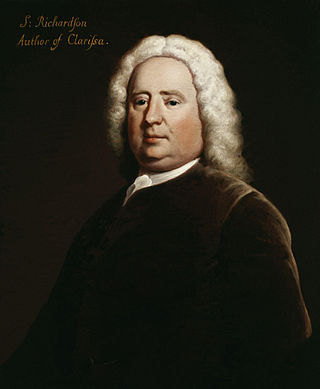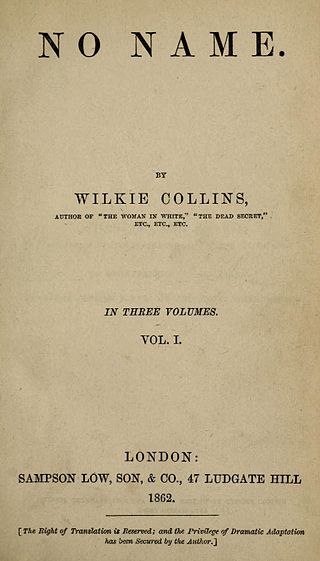
Samuel Richardson was an English writer and printer known for three epistolary novels: Pamela; or, Virtue Rewarded (1740), Clarissa: Or the History of a Young Lady (1748) and The History of Sir Charles Grandison (1753). He printed almost 500 works, including journals and magazines, working periodically with the London bookseller Andrew Millar. Richardson had been apprenticed to a printer, whose daughter he eventually married. He lost her along with their six children, but remarried and had six more children, of whom four daughters reached adulthood, leaving no male heirs to continue the print shop. As it ran down, he wrote his first novel at the age of 51 and joined the admired writers of his day. Leading acquaintances included Samuel Johnson and Sarah Fielding, the physician and Behmenist George Cheyne, and the theologian and writer William Law, whose books he printed. At Law's request, Richardson printed some poems by John Byrom. In literature, he rivalled Henry Fielding; the two responded to each other's literary styles.

The Rivals is a comedy of manners by Richard Brinsley Sheridan in five acts which was first performed at Covent Garden Theatre on 17 January 1775. The story has been updated frequently, including a 1935 musical and a 1958 episode of the TV series Maverick starring James Garner and Roger Moore, with attribution.
Hugh Kelly was an Irish dramatist and poet. From the 1760s he was employed as a propagandist for the British government, attacking members of the Opposition. After arriving in London in 1760 to work as a staymaker, he soon turned to become a writer and made a living as a journalist. In 1766 he published Thespis, a long poem about the acting profession, which gained him wide attention. He followed up this success with the novel Memoirs of a Magdalen in 1767. He ultimately became known for his stage plays such as False Delicacy and A Word to the Wise.
Sarah Fielding was an English author and sister of the playwright, novelist and magistrate Henry Fielding. She wrote The Governess, or The Little Female Academy (1749), thought to be the first novel in English aimed expressly at children. Earlier she had success with her novel The Adventures of David Simple (1744).

Clarissa; or, The History of a Young Lady: Comprehending the Most Important Concerns of Private Life. And Particularly Shewing, the Distresses that May Attend the Misconduct Both of Parents and Children, In Relation to Marriage is an epistolary novel by English writer Samuel Richardson, published in 1748. The novel tells the tragic story of a young woman, Clarissa Harlowe, whose quest for virtue is continually thwarted by her family. The Harlowes are a recently wealthy family whose preoccupation with increasing their standing in society leads to obsessive control of their daughter, Clarissa. It is considered one of the longest novels in the English language. It is generally regarded as Richardson's masterpiece.

Alexander Gordon, 4th Duke of Gordon, KT, styled Marquess of Huntly until 1752, was a Scottish peer who was described by Henry Home, Lord Kames as the "greatest subject in Britain". He was also known as the "Cock o' the North", the traditional epithet of the chief of Clan Gordon.

The History of Sir Charles Grandison, commonly called Sir Charles Grandison, is an epistolary novel by English writer Samuel Richardson first published in February 1753. The book was a response to Henry Fielding's The History of Tom Jones, a Foundling, which parodied the morals presented in Richardson's previous novels. The novel follows the story of Harriet Byron who is pursued by Sir Hargrave Pollexfen. After she rejects Pollexfen, he kidnaps her, and she is only freed when Sir Charles Grandison comes to her rescue. After his appearance, the novel focuses on his history and life, and he becomes its central figure.

Laetitia Pilkington was an Anglo-Irish poet. She is known for her Memoirs which document much of what is known about Jonathan Swift.

Sir Edmund Shaa or Shaw was a London goldsmith, Sheriff of London in 1475 and Lord Mayor of London in 1482. Shaa lent money to Edward IV and, as mayor, was extensively involved in the coronation of Edward IV's brother Richard III. He was later knighted and made a member of the Privy Council.
Events from the year 1767 in Ireland.

No Name is an 1862 novel by Wilkie Collins. Illegitimacy is a major theme of the novel. It was originally serialised in Charles Dickens's magazine All the Year Round before book publication. It is the second of his four "great novels", released after The Woman in White (1860) and before Armadale (1866) and The Moonstone (1868).
George Hastings, 1st Earl of Huntingdon, KB was an English nobleman.

Elizabeth de Vere, Countess of Oxford was an English noblewoman. As a young child she became a royal ward.

Emmeline, The Orphan of the Castle is the first novel written by English writer Charlotte Smith; it was published in 1788. A Cinderella story in which the heroine stands outside the traditional economic structures of English society and ends up wealthy and happy, the novel is a fantasy. At the same time, it criticises the traditional marriage arrangements of the 18th century, which allowed women little choice and prioritised the needs of the family. Smith's criticisms of marriage stemmed from her personal experience and several of the secondary characters are thinly veiled depictions of her family, a technique which both intrigued and repelled contemporary readers.
Colonel Brandon is a fictional character in Jane Austen's 1811 novel Sense and Sensibility. A quiet and reserved man, he forms an attachment to the middle Dashwood sister, Marianne whom he eventually marries happily.

The Widowed Wife is a 1767 comedy play by William Kenrick. It premiered at Drury Lane Theatre on 5 December 1767. It closely resembled the plot of Memoirs of a Magdalen a novel by Hugh Kelly. The play enjoyed a fairly successful run.
Grace, Lady Mildmay was an English noblewoman, memoirist and medical practitioner. Her autobiography is one of the earliest existing autobiographies of an English woman. Originally from Wiltshire, she married Sir Anthony Mildmay in 1567 and moved to Apethorpe Palace, his father's home in Northamptonshire. She practised medicine on her family and others, with an extensive knowledge of medical theory, and a large repertoire of cures. Her writings included memoirs, medical papers and devotional meditations.

Louisa Theodosia Jenkinson, Countess of Liverpool was a British noblewoman and the first wife of Robert Jenkinson, 2nd Earl of Liverpool, who served as prime minister from 1812 to 1827.
Sarah Chapone, born Sarah Kirkham and often referred to as Mrs Chapone, was an English legal theorist, pamphleteer, and prolific letter writer. She is best known for the treatise The Hardships of the English Laws in Relation to Wives, published anonymously in 1735.

Memoirs of Miss Sidney Bidulph is a 1761 novel by the Irish writer Frances Sheridan, published in three volumes.. A sentimental novel, it was strongly influenced by Samuel Richardson's 1748 novel Clarissa. Sheridan became acquainted with Richardson through her husband Thomas Sheridan's acting, and handed him the manuscript. Richardson was impressed and arranged for the book's publication. Like Clarissa it takes the form of an epistolary novel, in these case featuring its heroine's supposed memoirs. Sheridan was working on the a sequel to the story at her death in 1766, and a fourth volume known as the Conclusion of the Memoirs of Miss Sidney Bidulph was published posthumously in 1767. It inspired the 1772 play Die Entführung oder die zärtliche Mutter by German actress and playwright Friederike Sophie Seyler.













